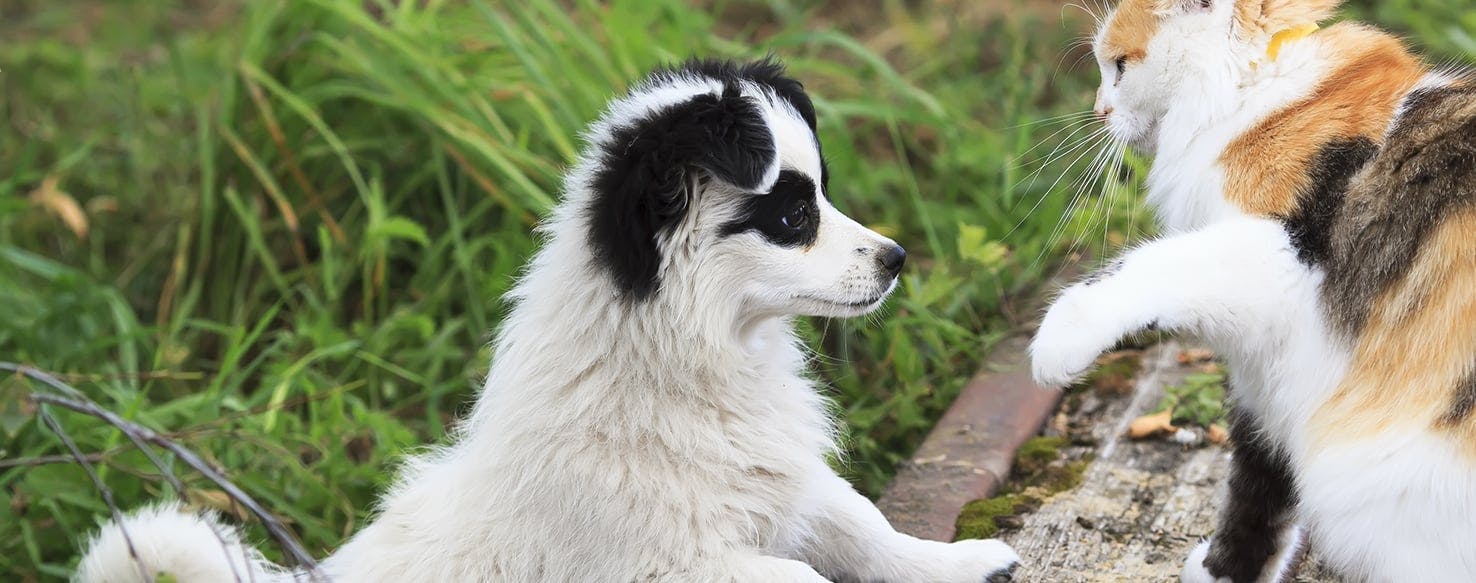If you have a cat and have been thinking about purchasing a puppy, chances are you have been wondering how to acclimate your canine to the feline. It can be done, and quite successfully, but it takes time and patience. Many cat owners set aside a day for the animals to meet one another; it may take less time than that, but the point is that the process need not be rushed.
There are many dogs and cats that get along very well…after the adjustment period. One important thing to understand is that if the cat was in the house first, and for a while (like a full-grown kitty or older cat) he may be quite inconvenienced by another animal coming in and setting up camp in “his territory.” Just like the toddler who suddenly becomes an older sibling – it is difficult at first. Here are steps to help you victoriously transition your new puppy into a household with a cat.
Step One: Separation
Before you bring your new baby home, put the cat in a room complete with the litter box, food, water, toys, his bed or favorite blanket, and anything else he uses for comfort. If you want to, and have previously visited the puppy, put a blanket in with the cat with his scent on it. Then, close the door. This may seem a little harsh, but it is necessary for the safety of both animals. When you bring the puppy home, even though the door is closed, both pets will be able to hear and smell each other. Both of them will quickly realize there is another animal in the house. This step is all about easing each animal into a nice transition. More than likely the cat will be the one who needs ease of transitioning the most since he was in the home first. If you feel your cat will be over-stressed, you can invest in a pheromone spray, which is a natural way to give your cat a sense of security during stressful times.
Step Two: Bond and Switch Rooms
Spend time with each animal, in their respected room, by playing, petting, and talking to both of them. Make them both feel comfortable. You will have to go back and forth, or if someone else is with you then both of you can take turns with each animal.
Next, hold the animals (keep them separate) and switch rooms. Let the animal walk around and explore (and sniff!) where the other one was. Repeat this process several times. Observe the behavior of the cat and the puppy. Does the cat look agitated? Does he act stressed? Or is he curiously sniffing without too much anxiety? These observations will give you a clue as to how long this transition may take. The puppy may act happy and just want to play, since he is the new one in the house. The goal is to have each animal feel relaxed in each room, so this may take some time. Patience is necessary throughout this stage.
Step Three: The Introduction
Once you are confident that both animals are comfortable with each other’s scents, it is time for them to meet face-to-face. At first, keep something between them, such as a baby gate or a kennel with a closed door for the cat and keep the puppy leashed at first. Even though they are finally meeting face-to-face, it is imperative to keep the environment controlled so neither animal panics or gets too excited, thus scaring the other animal. Understand that the cat may hiss, growl a low growl, or moan. The puppy will probably jump, romp, and bark. The cat will show some anger and feel threatened; the puppy will probably just be curious and want to play! This is totally normal, and for a split second, you may doubt your decision in bringing in the puppy. You may wonder if you have upset your cat to the point of no return, and may even feel a little guilty. Don’t worry, though. These behaviors are more than likely temporary, so try not to worry or be alarmed.
Step Four: The “Real” Meeting
Allow both pets to get to know each other without the boundaries, if you wish. This step is really up to you, and you do have options as only you know your pet. You can let both animals go free, but do not allow the puppy to chase the cat. If you think he will, leave the puppy on the leash when you let the cat out to be free. What happens next is unpredictable, and the cat may run off and hide. That’s quite okay (and normal!), so just let it happen.
Once you take the puppy off the leash, he may go looking for the cat, or he may be disinterested for the time being. Either way, you know that you have transitioned them properly, and you now need to give it time. Over time, they will get used to each other. If the cat runs into the closet, rest assured he will not stay there forever! Remember to give your pup plenty of opportunity for play, whether it be outside with you or a romp at the dog park. A tired and content pup is a happy one, less likely to give chase to the cat.
Many households and families enjoy many different types of pets. Dogs and cats can get along; it just takes time for them both to become familiar with one another. Once they get used to each other, they may even develop a mutual bond, play together, cuddle, and even sleep together! All it takes is a slow introduction and patience from that point on, and the rest is up to them. You will find that you made the right decision in your transition… and will be proud of your new family member!


